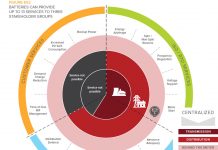John Petersen
The first quarter of 2011 was great for shareholders of companies that are developing or manufacturing cheap energy storage products like lead-acid and flow batteries, but it was miserable for shareholders of Chinese battery manufacturers and companies that are developing cool energy storage products like lithium-ion batteries. The following table tracks stock price performance in the energy storage sector for the first quarter of 2011 and for the twelve-months ended March 31, 2011.

The big winner for the quarter was Axion Power International (AXPW.OB), which seems to be recovering well from the intense selling pressure that kicked in about this time last year. The big winner for the twelve-month period was Active Power (ACPW), which is up 262% over the last year and up 1,027% since I bought it at $0.26 in December 2009. I knew I should have held onto Active Power longer.
The following summary table shows how my five tracking categories performed compared to broader market indexes.

My final table provides a summary of the key financial metrics I like to focus on when performing a high level forward looking analysis of the companies I track.

For companies with a history of losses, the first number I focus on is working capital. If a company can’t cover expected losses for the next year and make planned capital investments with available funds, it will almost certainly be forced to seek new financing and that can be difficult in a turbulent capital market. The seven companies that have clear working capital issues are identified with a red X in the working capital adequacy column. Altair Nanotechnologies (ALTI) and A123 Systems (AONE) have recently announced follow-on stock offerings that punished their stock prices while fortifying their balance sheets. Others will no doubt follow suit.
A second key metric is the difference between a company’s market capitalization and its book value, which is commonly referred to as blue-sky. Public companies normally trade at a premium to their book value because intangible assets like technologies, human resources, industry experience, customer relationships and the like usually have no balance sheet value. When the blue-sky premium is out of line on the high side, it’s a warning flag. When the blue-sky premium is out of line on the low side, it can hint at upside potential. While peer group comparisons aren’t always reliable, they can provide useful guidance.
Many investors spend a lot of time obsessing over quarterly results, but I believe trailing twelve-month numbers provide a clearer picture of how a company is performing because they smooth quarter-to-quarter changes in the business cycle and make it easier to spot companies that are performing better than their stock.
In my Cheap Sustainable Companies category, Exide Technologies (XIDE) is trading at a far more attractive valuation than either Johnson Controls (JCI) or Enersys (ENS). The price disparity is understandable because Exide is just now emerging from a couple of rough years. On a trailing twelve-month basis Exide is trading at 10.7 times earnings while JCI and Enersys trade at PEs of 18.6 and 19.6 respectively. A similar disparity shows up in the price/sales ratio where Exide trades at 0.3 times sales while JCI and Enersys are at 0.8 and 1.1 respectively. Since experience has demonstrated that the market prices of comparable companies tend to clump in the same range, I believe that there’s a 50% to 100% upside in Exide over the next 12 months.
As a group I tend to think the Chinese companies have been unfairly brutalized over the last year. There have been a few high profile problems with Chinese companies and those problems have cast a pall over the entire sector, but the battery manufacturers as a class seem to be well managed and profitable. Unfortunately the complexities of legal structures that work under both Chinese and American law are confusing to many. Moreover, cultural and language differences frequently put foreign companies at a distinct disadvantage in the US market and there are professional traders on the short side who seem intent on tarring the many with the faults of the few. As a result, Advanced Battery Technologies (ABAT), China Ritar Power (CRTP) and New Energy Systems (NEWN) are all trading at roughly four times trailing twelve-month earnings. I believe there are significant opportunities in this group for investors who are willing to dig into the details and look beyond the cultural differences.
The next twelve-months will be fascinating times in the energy storage sector as technology developers introduce a variety of products and ramp up demonstrations and deployments. I expect good things from Axion Power (AXPW.OB) as it begins a series of demonstration projects in the automotive stop-start, hybrid locomotive and stationary markets. While it’s a decidedly unpopular position, I continue to believe that cars with plugs will have a hard time meeting lofty market expectations. While their working capital positions are terrible, Beacon Power (BCON) and ZBB Energy (ZBB) seem to have more upside potential than downside risk and may be good speculations.
One final company that intrigues me is C&D Technologies (CHHPD.PK). Their stock price was savaged last year by intangible asset impairments and an NYSE delisting that forced a debt restructuring. Their current market capitalization of $125 million strikes me as low given the amount of debt that was eliminated in the restructuring and the rough numbers I’ve cobbled together from their historic SEC filings. The picture won’t be clear until they file their annual report later this month, but it looks like C&D has emerged from the restructuring in fine form and may offer significant opportunity to investors who are willing to spend some time digging.
Disclosure: Author is a former director of Axion Power International (AXPW.OB) and holds a substantial long position in its common stock.







